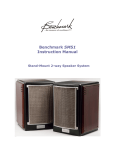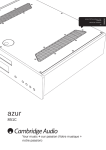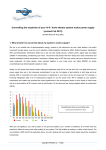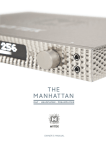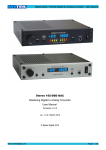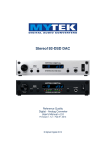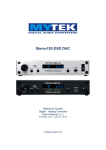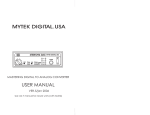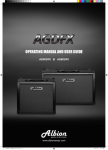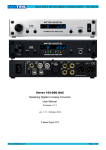Download MyTek Stereo 192 ADC Owner`s manual
Transcript
EQUIPMENT REPORT Three New DSDCapable DACs Mytek Stereo192-DSDDAC, Benchmark DAC2 HGC, and Lynx Hilo Reference A/D D/A Converter Steven Stone uring the years that J. Gordon Holt and I made recordings together he often complained about the lack of “pro” audio gear being reviewed in consumer audio publications. Many times he found a particular piece of gear that he wanted to review, but because it was sold and marketed principally to professional audio engineers, it was deemed by his editors to be inappropriate. He found this so irritating that he didn’t write as many reviews in his later years as he might have, if given freer rein. Gordon’s last reference speakers, the ATC SC40s, were just such a “prosumer” product. Flash forward ten years; computer audio has reduced the gap between pro and consumer gear to the point where they are almost interchangeable. This convergence of current-generation consumer and pro gear is a result of parallel technical paths. The latest computer-audio pro and consumer products employ the VDPH '$&V VRIWZDUHÀUPZDUH VROXWLRQV DQG FLUFXLWWRSRORJ\ concepts. Nowadays differences in input/output options, routing ÁH[LELOLW\DQGFRVPHWLFVKDYHEHFRPHWKHSULPDU\GLIIHUHQWLDWRUV separating pro from consumer devices. The latest generations of state-of-the-art DAC chips from Cirrus Logic, Wolfson, and ESS have the built-in capability to QDWLYHO\ VXSSRUW WKH '6' IRUPDW 7KH ÀUVW '$&V WR XWLOL]H this added capability are from companies whose prime focus has been the pro market: Mytek, Benchmark, and Lynx. But D 150 July/August 2013 the absolute sound the $1595 Mytek Stereo192-DSD-DAC, $1995 Benchmark DAC2 HGC, and $2495 Lynx Hilo all bridge the gap between pro and consumer so completely that, except for where they are purchased, the difference is moot. I have no doubt that this would have pleased J. Gordon Holt immensely. The Mytek Stereo192-DSD-DAC Manufactured in Poland, the Mytek Stereo192-DSD-DAC was designed by Michal Jurewicz, who is also the founder of Mytek 'LJLWDO 0\WHN RSHQHG LWV GRRUV LQ DQG LWV ÀUVW SURGXFWV were A/Ds and D/As for the pro recording market. According to one of Mytek’s background papers, “The ADCs and DACs prototypes designed by Michal have been used to record many now classic albums of David Bowie, Lou Reed, Mariah Carey, James Taylor, B52’s, and many more.” In 2005 Jurewicz was commissioned to design a DSD master-recorder for Sony’s SACD division. And while SACD’s moment in the audio sun was distressingly brief, the experience put Jurewicz in an ideal position to make a DAC/pre that supports DSD. The Mytek Stereo192-DSD-DAC comes in three versions. The differences involve ergonomics and cosmetics. Fortunately for consumers, all three have the same price. The “standard” YHUVLRQLVDYDLODEOHLQWZRÀQLVKHVVLOYHUDQGEODFN7KHEODFN chassis 192-DSD-DAC has front-panel volume-level LEDs EQUIPMENT REPORT - Three New DSD-Capable DACs below the LCD panel, while the silver version has none. Input and output options on the black and silver 192s are identical. The “Mastering” Stereo192-DSD-DAC has a front panel similar to the black standard version, but instead of an analog passthrough it substitutes a dedicated DSD input for 128x (5.6MHz) ÀOHV FXUUHQWO\ RQO\ DFFHVVLEOH E\ D 3&EDVHG FRPSXWHU )RU audiophiles who want to use an analog source, the standard version with its analog inputs will be the more useful option. Having the “idiot light” level-meter LEDs on the front panel makes the blackface version my preference over the silver face. Mytek sent me two Stereo192-DSD-DACs, a black standard as well as a mastering version. For the review I used the standard version. I did listen to the mastering version near the end of the review period, primarily to see if the 400-plus hours of playing time I had put on the standard version had any effect on the sound compared to a brand-new unit with no playing time. There was a profound difference. The unused mastering version had a midrange glare and harder edge that was not present in the broken-in sample. Anyone evaluating a Mytek Stereo192-DSDDAC that has not been thoroughly broken-in hasn’t really heard how a Mytek Stereo192-DSD-DAC can sound. I recommend at least 200 hours with an active signal. I left my review sample tethered to a Logitech Duet tuned to my local public radio’s Internet feed for nearly two weeks before I placed it into my desktop system. Setup and Day-to-Day Use Installing the Mytek Stereo192-DSD-DAC in my desktop system was easy and straightforward. It has a single pair of balanced XLR outputs as well as a single RCA single-ended output. The EDODQFHGRXWSXWZHQWWRP\SRZHUDPSOLÀHUZKLOHWKHXQEDODQFHG RXWSXWZHQWWRERWKD6WD[6507KHDGSKRQHDPSOLÀHUDQG Velodyne DD10+ subwoofer. The Mytek is unique among the three DAC/pre’s in this review because it has a FireWire input in addition to its USB inputs. I connected both the FireWire and USB connections from my computer as well as a S/PDIF feed from an Empirical Audio Off-Ramp 5 USB to S/PDIF converter. The Stereo192-DSD-DAC has two USB inputs, one for 1.0 USB and the other for 2.0. For both Macs and PCs you need to download and install a driver to support USB 2.0. If you don’t have the proper driver, you can use the 1.0 USB input sans driver. Given how easy it was to install the Mytek driver, I can’t think of any reason besides being completely cut off from the Internet for not downloading and installing the Mytek drivers. Once USB and FireWire drivers were installed, both the USB 2.0 and FireWire outputs were recognized and visible in my Mac’s Audio MIDI control panel. The Mytek’s front panel has only one knob, three pushbuttons, a 3" by ½" LED front-panel display, a ¼" stereo headphone output, and an on/off switch. The knob does quadruple-duty, serving as an independent volume control for both rear-panel outputs as well as for the headphone level. Also by pushing the volume control in slightly it converts to a mode selector that turns to select different options within each mode. A push while in a mode selects whichever choice is displayed in the front panel LED read-out. This multi-function control-design does require some “user training.” But after using the Stereo192-DSD-DAC 152 July/August 2013 the absolute sound SPECS & PRICING Mytek Stereo192-DSD-DAC Conversion: 32-bit, PCM up to 192k, 64x DSD, 128x DSD Digital inputs: S/PDIF, AES/ EBU, TosLink, all up to 192k single wire (64xDSD and 128XDSD SDIF DSD interface on Mastering Version) Analog inputs: One pair singleended RCA Outputs: One pair balanced XLR, one pair unbalanced RCA, one headphone output Dimensions: 8.5" x 1.72" x 8.5" Weight: 6 lbs. Price: $1595 MYTEK DIGITAL 148 India Street, 1st Floor Brooklyn, NY 11222 (347) 384-2687 mytekdigital.com Benchmark DAC2 HGC Conversion: 32-bit, PCM up to 194kHz, 64x DSD Analog inputs: One stereo pair Digital inputs: One USB, two optical, two coaxial Outputs: One pair balanced XLR, two pairs unbalanced RCA, one headphone output Dimensions: 9.5" x 1.725" x 9.33" Weight: 3 lbs. Price: $1995 BENCHMARK MEDIA SYSTEMS, INC. 203 East Hampton Place, Suite 2 Syracuse, NY 13206 (800) 262-4675 (800-BNCHMRK) [email protected] EBU, one S/PDIF coaxial, one TosLink, one USB Outputs: One pair balanced XLR, one pair single-ended RCA, one headphone output Dimensions: 8.50" x 3.25" x 10.00" Weight 6.75 lbs. Price: $2495 LYNX STUDIO TECHNOLOGY, INC. 190 McCormick Avenue Costa Mesa, CA 92626-3307 (714) 545-4700 [email protected] ASSOCIATED EQUIPMENT Source Devices: MacPro model 1.1 Intel Xeon 2.66 GHz computer with 16 GB of memory with OS 10.6.7, running iTunes 10.6.3 and Amarra 2.5 music playing software, Pure Music 1.85 music playing software, and Audirana Plus 1.35 music playing software Amplifiers: April Music Eximus S-1, Accuphase P-300, Parasound A-23 Speakers: Aerial Acoustics 5B, ATC SC-7, ProAC Anniversary Tablettes, Role Audio Canoe, Golden Ear Aon 2, Silverline Miuet Plus, Velodyne DD+ 10 subwoofer Cables and Accessories: Wireworld USB cable, Synergistic Research USB cable, AudioQuest Carbon USB cables. PS Audio Quintet, AudioQuest CV 4.2 speaker cable, AudioQuest Colorado interconnect, Cardas Clear interconnect, and Crystal Cable Piccolo interconnect Lynx Hilo Conversion: 24-bit, PCM up to 192kHz, 64x DSD Analog inputs: One pair balanced XLR Digital inputs: One AES/ Comment on this article at www.theabsolutesound.com EQUIPMENT REPORT - Three New DSD-Capable DACs exclusively for a week or so the logic of Mytek’s nested menu options becomes second nature. The Stereo192-DSD-DAC also supports a remote control, an Apple remote to be exact. Any Apple remote can be coupled to the Stereo192-DSD-DAC, as can an RC-5-style universal remote. Two of the small buttons on the front panel are function buttons. They are both userSURJUDPPDEOH WR VHUYH DV D VSHFLÀF LQSXW VHOHFWRU D PXWH D phase inversion select, a mono select, an L-R select, an M/S decode, or for instant -20dB volume reduction. Unlike many DAC/preamps which have their volume controls for the headphone and main outputs ganged together, the Mytek supports separate volume control adjustments from a single volume knob. Merely push in the knob to switch from headphones to line level. The front panel LED displays a -99 to -0 volume scale, making it easy to see exactly what your volume level is at a glance. It also makes matched-level A/B comparisons easy and accurate. If you already have a line-level analog preamp, \RX FDQ VHW WKH 0\WHN 6WHUHR'6''$& IRU À[HGOHYHO analog output. 7KHRQO\FRQWURORQWKHIURQWSDQHOWKDW,GLGQRWÀQGRI YDOXH was the on/off switch. Every device needs an on/off switch, right? True, but perhaps a smaller or rear-mounted on/off would have been better. Why? Because when the Mytek is turned on or off it emits a rather loud transient thump. Obviously, best practices indicate that you should always turn your power DPSOLÀHU DQG VXEZRRIHU RQ ODVW DQG WXUQ WKHP RII ÀUVW 7KLV will eliminate the possibility of the turn-on and turn-off noise damaging anything downstream from the 192-DSD-DAC. But, “things happen.” The DAC/pre’s in my desktop system are situated below my desk at approximately knee height. Several times during the review my knee came in contact with the on/ off switch. The results were loud and not pretty. Also, once GXULQJWKHUHYLHZ,KDGDSRZHURXWDJHDQGP\SRZHUDPSOLÀHU exhausted its power reserves, generating a prodigious thump. Knowing “best practices” and being able to employ them in the real world are two different things. Sound 7KHÀUVWWKLQJWKDWLPSUHVVHGPHDERXWWKH0\WHN·VVRQLFVZDV the lack of any additive harmonic colorations. Conversely, the Mytek didn’t sound harmonically thin; instead there was a clarity and speed to its presentation that gave everything played through it the lucidity of live music. If your system relies on your DAC or preamp to warm up or harmonically enrich the overall tonal balance, the Mytek Stereo192-DSD-DAC won’t be much help. Like the other two prosumer DAC/pre’s in this survey, the Mytek DAC was created to be as neutral and transparent as possible. And in my system, it achieved this goal. Although the Mytek is extremely neutral, it does have more than one sonic personality. The upsampling option, as well as WKHWZR3&0ÀOWHUFKRLFHVPDGHDQRWLFHDEOHGLIIHUHQFHLQKRZ the Mytek sounded. With lower-bit-rate sources, such as MP3s and audio from video streams, upsampling delivered superior ORZOHYHO GHÀQLWLRQ LPDJH VROLGLW\ DQG EHWWHU SDFH %XW ZLWK KLJKHUUHVROXWLRQ GLJLWDO ÀOHV , JHQHUDOO\ SUHIHUUHG WKH QRQ oversampling native rate. Sampling rates of 44.1 and higher sounded more organic and analog-like. The same tracks with oversampling activated were too tight and sounded overdamped. 154 July/August 2013 the absolute sound 7KH WZR VHOHFWDEOH 3&0 ÀOWHU VORSHV IDVW DQG VORZ ZHUH IDU more program-material dependent than bit-rate dependent. The RQO\ ZD\ WR GHWHUPLQH ZKLFK ÀOWHU VRXQGHG EHVW ZLWK D JLYHQ SLHFHRI PXVLFZDVWROLVWHQWRERWKÀOWHURSWLRQV 7KH0\WHNDOVRVXSSOLHVWKUHHGLIIHUHQWKLJKIUHTXHQF\ÀOWHUV for DSD—50, 60, or 70kHz. Frankly I didn’t hear any appreciable GLIIHUHQFHVEHWZHHQWKHWKUHHÀOWHUVRQP\RZQ'6'UHFRUGLQJV but they were all recorded at 5.6MHz with the high-frequency ÀOWHURQVRPXFKRI WKHKLJKIUHTXHQF\QRLVHWKDWWKHVHÀOWHUV DUHGHVLJQHGWRÀOWHURXWZDVDOUHDG\DEVHQWIURPP\UHFRUGLQJV On the few commercial DSD recordings in my library I did notice some very subtle differences, which seemed to primarily DIIHFW VRXQGVWDJH VL]H $V WR ZKLFK '6' ÀOWHU ZDV EHVW WKDW once again was dependent on the source material. Speaking of source material, I found the Mytek was among the most dynamically mercurial DACs I’ve encountered. With lowcontrast, “volume wars” commercial pop, such as the audio from &DUO\5DH-HSVHQ·V´&DOO0H0D\EHµWKH0\WHNVRXQGHGÁDWDQG lacking in dynamic contrast. But when fed something with actual dynamic contrast, such as my own live concert recordings, the Mytek reproduced the recording’s full dynamic range and power with ease. During especially high-dB passages, such as the peaks on my recording of “A Woman’s Life” by Richard Danielpour performed by the Boulder Philharmonic with soloist Angela Brown, the Mytek did a superb job of delineating the penetrating power of Ms. Brown’s impressive mezzo-soprano. The Mytek’s headphone output proved to be up to the task of driving the most power-hungry headphones in my collection with no issues, including the Audeze LCD-2 and Beyer Dynamic DT990 600-ohms. High-sensitivity in-ear phones were also handled well by the 192-DSD-DAC. The 16-ohm-impedance, 110dBsensitive Meelectronics A161P lacked any sort of additional electronic noise or hiss, and had excellent bass and treble extension. The Mytek dual volume control was especially handy when I was comparing my Stax headphone rig with dynamic headphones plugged into the Mytek’s headphone output, since it allowed me to critically match the levels of the headphone with the Stax being fed by the line-level outputs. Is a Mytek Your Tech? Although the Mytek is the least expensive of the three DAC/ pre’s in this survey, its combination of features and sound puts it on equal footing with the other two units reviewed. If you want or need a DSD-capable DAC with a FireWire interface (which can be attached to any Thunderbolt connection via an adapter) the Mytek is the only game in town, so far. For most prospective buyers the blackface standard version with its analog pass-through will be the most useful, but if you have a PC and a hankering for 128x DSD and don’t need an analog input, the ´0DVWHULQJµYHUVLRQZLOOÀOOWKHELOOQLFHO\ Benchmark DAC2 HGC When Robert Greene reviewed the Benchmark DAC1 in 2009, he concluded his review by saying, “The Benchmark DAC1 Pre is not only an excellent device for the money; it is excellent compared to anything that I have encountered at any price. To my mind, it is the beginning of a new era in audio, in which the regeneration of the recorded signal has become a solved EQUIPMENT REPORT - Three New DSD-Capable DACs problem.” His review generated quite a bit of controversy, with some audiophiles agreeing that the DAC1 was utterly transparent, DQGRWKHUVÀQGLQJLWWREHRYHUO\PDWWHURIIDFWDQGODFNLQJLQDLU pace, and ambience retrieval. ([FHSW IRU KHDULQJ D '$& EULHÁ\ DW VHYHUDO DXGLR VKRZV , haven’t spent much time listening to the DAC1 so I wouldn’t venture an opinion on its ultimate sonic quality. But after more than three months with the Benchmark DAC2 HGC I can’t help but think that it will convert Benchmark naysayers into fans. Going From DAC1 to DAC2 How does the Benchmark DAC2 HGC differ from its predecessor? It looks very much the same to the casual eye since it has a similar physical footprint and front-panel layout. According to the DAC2 HGC’s owner’s manual, “New features have been added to extend the versatility of the product, and improve the listening experience. These features include: native DSD conversion, asynchronous USB 2.0, asynchronous USB 1.1, home-theater bypass, digital pass-through, polarity control, word-length display, sample-rate display, a bi-directional 12V trigger, and additional I/O options.” Additional “performance improvements” include using four balanced 32-bit D-to-A converters that are summed to make each balanced output channel. According to Benchmark this reduces noise by 6dB. Overall the DAC2 is 10dB quieter than the DAC1. The DAC2 also includes 3.5dB of digital-processing headroom above 0dBFS, which reportedly eliminates the clipping that can be caused by inter-sample overloads. 7KH '$& +*& HPSOR\V QHZ KLJKHIÀFLHQF\ ORZQRLVH power supplies with each subsystem using its own dedicated low-noise regulation. The UltraLock2 digital clock replaces the older UltraLock clock that was used in the DAC1 for jitter attenuation. Like most current-generation DACs, the DAC2 uses an asynchronous interface, which Benchmark, with a knack for verbal invention, calls its “multi-mode asynchronous USB.” The HGC moniker stands for “hybrid gain control” which is a “dual domain” attenuation system that combines digital with analog gain controls for an optimal result. By using a 32-bit digital system along with a servo-driven analog potentiometer, Benchmark claims that the HGC design “outperforms traditional analog or digital volume controls, including the two-stage DAC1 HDR system.” The expanded input options for the DAC2 HGC include two pairs of unbalanced analog stereo inputs, two optical digital inputs, two coaxial S/PDIF inputs, and one USB 2.0 input. Output options comprise two pairs of unbalanced RCA stereo outputs, one balanced XLR stereo output, and two ¼" stereo headphone outputs on the front panel. All the outputs are attenuated by the front-panel rotary volume control. The DAC 2 +*&·VVHFRQGFRD[LDO63',)GLJLWDOLQSXWFDQEHUHFRQÀJXUHG to be a digital output, so that any digital source that comes into the DAC2 HGC can be rerouted to any additional external digital devices you have on hand, such as another DAC or digital recorder. Most of the front panel’s operating adjustments are duplicated on the DAC2’s dedicated remote control. Looking very much like the remote that Bel Canto used several years ago for its PRE-3 analog preamp (the Bel Canto was plastic; the Benchmark die158 July/August 2013 the absolute sound cast aluminum), the DAC2 HGC remote handles volume, input switching, LCD levels, and on/off functions. The only control not duplicated on the remote is polarity reversal. To invert the polarity you must push a small button on the DAC2 HGC’s front panel or the remote control’s On button. Like its predecessor the DAC1, the DAC2 has a pair of ¼" stereo headphone outputs on its front faceplate. Benchmark calls LWVKHDGSKRQHDPSOLÀHUFLUFXLWWKH+3$%HQFKPDUNFODLPVLW LV´RQHRI WKHPRVWWUDQVSDUHQWKHDGSKRQHDPSOLÀHUVDYDLODEOHµ with a “near 0-ohm” output impedance for optimum damping with a wide variety of headphones. Setup and Day-to-Day Operation Setting up the DAC2 HGC was straightforward with few surprises. For my desktop system I connected the balanced XLR outputs WRP\SRZHUDPSOLÀHUDQGRQHRI WKHVLQJOHHQGHG5&$RXWSXWV to my subwoofer, while the other RCA single-ended output was FRQQHFWHGWRP\6WD[650WKHDGSKRQHDPSOLÀHUZKLFKZDV GDLV\FKDLQHGWRD6LFSKRQHVKHDGSKRQHDPSOLÀHU Inside the DAC2 HGC Benchmark included a pair of jumperenabled passive attenuators for the balanced XLR outputs. This switch lets users choose either 0dB, 10dB, or 20dB of attenuation. The purpose of the attenuators is to match the DAC2 HGC’s output levels to your amp and speaker sensitivity. Benchmark recommends that for optimal performance the volume control should be set above 11 o’clock. The DAC2 came with the jumpers set for -10dB, which I reset for -20dB. For desktop use I found that -10dB was far more gain than I needed with the amps and speakers I had on hand. '$&SUHDPSV WKDW LQFOXGH D KHDGSKRQH DPSOLÀHU XVXDOO\ operate one of two ways—either all the other outputs are muted when a headphone is plugged into the front panel or they remain active. Both schemes have their adherents and detractors. Benchmark came up with a clever compromise. If you use the left-hand jack the DAC2 attenuates its other outputs, but if you use the right-hand jack all outputs remain active. Benchmark’s solution is hard to fault. Since the DAC2 HGC uses a servomotor to control its remote volume adjustments, volume changes aren’t as instantaneous as they are with an all-electronic volume control. Once you release the volume control button on the remote the DAC2 volume continues to travel for a fraction of a second. Also the volume knob has no detents (or numerical equivalents on an LED readout), so recreating exact volume levels can only be done “by eye” using the small red dot on the volume knob and the dot markings around the outside circumference of the knob. I found turning the control manually rather than relying on the remote worked best for achieving critically matched volume levels. The DAC2 Sound Although the latest generation of DAC chips and circuits claims to have achieved that elusive goal of bit-perfect sound reproduction (still debatable), different approaches to digital signal processing and analog circuitry create more than enough variations in sound quality to give most DACs their own unique sonic personalities. Benchmark says that the DAC1 and DAC2 use nearly identical analog circuit. The difference is the DAC2’s ESS Sabre conversion and DSP headroom. The company says that in the DAC1 the EQUIPMENT REPORT - Three New DSD-Capable DACs analog circuit outperformed the DAC by a wide margin, but in the DAC2 the superior DAC and DSP allows the conversion stage to approach the limits of the analog circuitry. Most of the negative comments I’ve read about the DAC1 revolved around its lack of dimensionality and dynamics, rendering its presentation overly left-brained and emotionally uninvolving. The DAC2 is quite different. The DAC2 sounded dynamically wide open with superb dimensionality and tonal color. Over the course of my listening sessions using the DAC2 HGC I was hard-pressed to come up ZLWK DQ\ HDVLO\ LGHQWLÀDEOH DGGLWLYH RU VXEWUDFWLYH FRORUDWLRQV RU sonic personality that I could identify as intrinsic to the DAC2’s core sound that veered from the center path of neutrality. The one sonic characteristic that I was constantly aware of when listening through the DAC2 was the quality of the recording itself. Whether it was a lowly 320bps MP3 or a 64x '6'ÀOH,ZDVFRQWLQXDOO\UHPLQGHGRI KRZWKHUHFRUGLQJZDV made and how well or poorly executed the original recording session was. Excessive or inappropriately applied reverb was immediately obvious, such as on the otherwise musically superb duet album by Chris Thile and Mike Marshall Into the Cauldron. Through the DAC2 the reverb sounds so obviously overdone that it’s actually easier to listen around it because the DAC2’s lack of grain and electronic texture separates the original signal from the awful afterthought reverb. Low-level resolution through the DAC2 was exemplary. On my own live Boulder Philharmonic Orchestra DSD recordings 160 July/August 2013 the absolute sound the little extra amusical noises from chairs and the more than 700 humans in the room during a concert were easier to discern and separate out from the music. Depth cues were also slightly more coherent on my DSD recordings played back through the DAC2, especially when compared to my 44.1 conversions from the same DSD masters. I should mention that although the DAC2 plays back 2.8MHz ÀOHV[LWGRHVQRW\HWVXSSRUW0+]['6'ÀOHV$OO of my live DSD recordings were made at 128x, so for playback I must convert them to 64x. I’ve used two programs for the conversion. Most of the time I use AudioGate, but Daniel Weiss suggested I try his Saracon software, which is a dedicated standDORQHSURJUDPFUHDWHGVROHO\WRFRQYHUWÀOHVIURPRQHIRUPDWWR another. When I compared the PCM 192/24 conversions done with both programs they did not sound identical. The Saracon program’s overall output levels in default mode were different. I needed to spend quite a bit of time tweaking the settings in 6DUDFRQWRJHWWKHWZRSURJUDPVWRFUHDWHÀOHVWKDWKDGVLPLODU levels, since AudioGate has no level adjustments. When levels were as critically matched as possible, I found that the Saracon ÀOHV GLG VRXQG DV LI WKH EODFN VSDFH EHWZHHQ LQVWUXPHQWV ZDV ever so slightly blacker, but the effect was very subtle and only really noticeable on especially quiet passages. I’m bringing up the issue of format conversion because , IRXQG WKDW KRZ D ÀOH KDV EHHQ FRQYHUWHG IURP RQH IRUPDW to another had a far more profound sonic effect than any of Three New DSD-Capable DACs - EQUIPMENT the electronics in my playback chain. And anyone who’s doing FRPSDULVRQVEHWZHHQ'6'DQG3&0YHUVLRQVRI DÀOHQHHGVWR give greater consideration to his conversion methodology. If a reviewer doesn’t know or hasn’t bothered to control how a DSD ÀOHZDVFRQYHUWHGWR3&0KLVFRQFOXVLRQVDERXWVRQLFTXDOLW\ and differences between PCM and DSD are highly suspect. Anyone who says that a particular DAC is “better” than another DWSOD\LQJEDFN3&0RU'6'ÀOHVEDVHGRQVRPHRQHHOVH·VÀOH conversions needs to reevaluate his methodology, because the VRQLFYDULDWLRQVFUHDWHGE\ÀOHFRQYHUVLRQDUHLQP\H[SHULHQFH greater than the differences in hardware and software being compared. +HUH·V DQ H[DPSOH RI ZKDW D PDMRU SDUW ÀOH FRQYHUVLRQ FDQ SOD\LQVRXQGTXDOLW\:KHQ,SOD\HGEDFNWZRGLIIHUHQWÀOHVIURP WKHVDPHVHVVLRQRQHWKH´QDWLYHµ[ÀOHDQGWKHRWKHUD[ ÀOH WKDW ZDV PDGH WKURXJK D 6DUDFRQ FRQYHUVLRQ , SUHIHUUHG WKHVRXQGRQWKH['6'ÀOH:K\"3HUKDSVEHFDXVHWKH[ '6'ÀOHZDVSOD\HGEDFNLQQDWLYHPRGHYLD'6'RYHU'R3 ZKLOHWKH[ÀOHZDVEHLQJFRQYHUWHGRQWKHÁ\E\WKH'HFLEHO SOD\EDFN SURJUDP LQWR D 3&0 ÀOH 7KH QDWLYH '6' ÀOH playback was more relaxed, natural, and, dare I say it, analog-like in presentation. Benchmark made some bold claims about the quality of the KHDGSKRQH DPSOLÀHU LQ WKH '$& :LWK DOO WKH KHDGSKRQHV , had available the DAC2 headphone amp rivaled the sonics of WKHVWDQGDORQHL)LL&DQKHDGSKRQHDPSOLÀHU,UHYLHZHGUHFHQWO\ REPORT (Issue 233). On all the commercially-available recordings I tried the DAC2 had enough gain to handle the most power-hungry and LQHIÀFLHQWKHDGSKRQHVVXFKDVWKH%H\HU'\QDPLF'7 ohm version and the Audeze LCD-2. With my own recordings DQG WKH '$&·V GHIDXOW KHDGSKRQH DPSOLÀHU JDLQ VHWWLQJ , ZRXOGKDYHOLNHGDELWPRUHJDLQIRUWKHVHORZHUHIÀFLHQF\FDQV EXWZLWKPRUHHIÀFLHQWFDQVVXFKDVP\%H\HU'\QDPLF'7 250-ohms, the DAC2’s headphone amp had ample gain. Note that the headphone gain range is internally adjustable in 10dB steps (0dB, -10dB, -20dB), with the factory default at -10dB. This YDULDEOHJDLQRSWLPL]HVWKHKHDGSKRQHDPSOLÀHU·VJDLQVWUXFWXUH for the highest signal-to-noise ratio. 2Q KLJKHIÀFLHQF\ ORZLPSHGDQFH HDUEXGV VXFK DV WKH Meelectronics A16P balanced-armature earbuds, there was no low-level hiss, spurious noise, or other signs of excessive gain. After many hours of headphone listening I had to conclude that the headphones themselves, rather than the DAC2 headphone DPSOLÀHU ZHUH WKH PRVW FRORUHG DQG OHDVW QHXWUDO SDUW RI WKH DAC2’s headphone output reproduction chain. Another Perfect Benchmark DAC? While I would never be so brash as to even suggest that further improvements in DACs, USB interfaces, and analog circuitry aren’t possible or won’t result in better sound quality, the Benchmark DAC2 does make a strong case that the currentgeneration digital-to-analog interfaces are no longer the weakest the absolute sound July/August 2013 161 EQUIPMENT REPORT - Three New DSD-Capable DACs link in the reproduction chain, if indeed they were in the past. For me the bottom line on the Benchmark DAC2 HGC is that is it not only good enough to live with long-term, it’s good enough to use for any mastering or recording projects that might come up. The DAC2 HGC is easy to listen through, highly revealing, and with well-recorded material astonishingly three-dimensional. 64x (2.8MHz) for DSD. The Hilo includes a built-in two-channel analog-to-digital converter, so analog sources can easily be brought into the digital GRPDLQ7RJHWDQLGHDRI KRZÁH[LEOHWKH+LORFDQEHDQGKRZ it can be used, Lynx has over a dozen downloadable fact sheets on its site that cover how to employ the Hilo for overdubbing, mastering, location recording, and archiving vinyl records. Lynx Hilo /\Q[6WXGLR7HFKQRORJ\ZDVIRXQGHGLQ,WVÀUVWRIIHULQJV were PCI sound cards for computer-audio interfaces. While PCI cards still play a prominent role in Lynx’s lineup, its latest devices have been stand-alone digital interface gear such as the Hilo Reference A/D D/A Converter System. The Hilo incorporates D QXPEHU RI ÀUVWV IRU D SUR DXGLR GHYLFH LQFOXGLQJ D IXOO FRORU[/&'WRXFKVFUHHQDQGXSJUDGDEOHÀUPZDUHWKDW controls all of the Hilo’s primary functions. My review sample +LORZDVRQLWVÀIWKÀUPZDUHYHUVLRQ The Hilo combines a unique feature set with one of the most ÁH[LEOH VLJQDOURXWLQJ V\VWHPV ,·YH VHHQ LQ DQ\ '$& RU GLJLWDO SUHDPS7KLVÁH[LELOLW\VWHPVIURPLWV)3*$ÀHOGSURJUDPPDEOH gate array). Virtually any input can be routed to any output. Also any input can be routed to play from any of Hilo’s three outputs—line, monitor, or headphone. Hilo simultaneously supports eight digital channels at 192/24 or sixteen channels at 96/24. With the addition of Lynx LT-USB L-Slot, the Hilo also supports USB 2.0 inputs at bit-rates up to 192/24 for PCM and 162 July/August 2013 the absolute sound Setup and Day-to-Day Use *LYHQ WKH +LOR·V OHYHO RI ÁH[LELOLW\ QHZ XVHUV VKRXOG H[SHFW a learning curve when they begin. I recommend reading the manual thoroughly before trying to set up the Hilo. I didn’t follow my own advice and paid the price. Unlike most digital preamps I’ve reviewed in the past, the Hilo’s “line out” was a À[HGOHYHORXWSXWZKLOHWKH´PRQLWRURXWµZDVDYDULDEOHOHYHO output controlled by the volume knob on the front panel. If you assume, as I did, that the “line out” would be the variableYROXPHRXWSXWZKLOHWKH´PRQLWRURXWµZRXOGEHÀ[HGOHYHODV is standard on most consumer audio devices, you stand a good FKDQFHRI EORZLQJXS\RXUVSHDNHUGULYHUVZKHQWKHÀUVWVLJQDO goes through the Hilo. I had two seconds of panic when a pair of ProAc Tablettes got exposed to full-scale output from an Accuphase P-300 before I WXUQHGRII P\SRZHUDPSOLÀHU3KLO0RRQ/\Q[·V93RI VDOHV and marketing, explained to me that in order to make the “line out” the “alpha” best-quality output, Lynx decided to bypass the EQUIPMENT REPORT - Three New DSD-Capable DACs volume controls. Perhaps on subsequent versions Lynx could FKDQJH LWV ODEHOLQJ IURP ´OLQH RXWµ WR ´À[HGOHYHO OLQH RXWµ WR avoid subjecting overeager users to the sonic blast I experienced. If you wish to use the Hilo to directly drive a basic power DPSOLÀHU RU DFWLYH VSHDNHUV WKDW ODFN WKHLU RZQ YROXPH adjustments, you must use the “monitor out” outputs. Since the “monitor out” uses stereo ¼" terminations, some kind of adapter will be needed for use with either RCA or XLR termination. For my primary desktop set-up I used a ¼"-to5&$ DGDSWHU DQG D VSOLWWHU WR FRQQHFW WR P\ SRZHU DPSOLÀHU and subwoofer. I connected the “line out” to a Stax SRM-007t KHDGSKRQHDPSOLÀHU Once all the physical connections were sorted out it was time to work through the set-up options via the Hilo’s frontSDQHOWRXFKVFUHHQ7KHÀUVWRSWLRQLVZKDWNLQGRI OHYHOPHWHUV you would like to see. The Hilo offers three options—analog, horizontal, or all I/O. Four additional control screens cover all RI +LOR·VRWKHURSWLRQVZKRVHGHVFULSWLRQVFRXOGHDVLO\ÀOOXS WKHUHPDLQGHURI WKHUHYLHZ6XIÀFHLWWRVD\WKDW\RXFDQGRIDU more with the Hilo than merely output two channels of audio. You can, if you so desire, send different signals to each output or compare two different mixes over the same output for A/B comparisons. The Hilo also has an internal sample-rate converter to upconvert or downconvert a digital signal and then send it to any of the Hilo’s three digital outputs. 2QHIHDWXUHWKDW\RXZRQ·WÀQGRQFRQVXPHU'6''$&VLVWKH Hilo’s “Scene” feature. Imagine a “save” function that preserves all your current settings and lets you recall them with one button push. The Hilo has six savable “scene” options, which can be used for matched-level A/B switching (as I did) or special setups. 2QFHGLDOHGLQWKH+LORSHUIRUPHGÁDZOHVVO\WKURXJKRXWWKH review period. It recognized DSD streams with no stuttering or glitches and switched easily and automatically from one format and bit-rate to another. Unlike other DACs I’ve reviewed that require the user to choose the active input source, the Hilo automatically defaulted to whichever input was currently passing signal. When I switched from the Hilo’s USB to the Empirical Audio Off-Ramp 5 USB converter via my MAC’s MIDI control, the Hilo automatically and almost instantaneously switched from USB to S/PDIF with virtually no interruption. Unlike both of the other DSD DACs in this review, the Hilo does not come with a remote. For some potential users this could be a “fail” moment, but given the feature-rich nature of the Hilo’s LCD touchscreen interface, it makes far more sense to use the Hilo in a physical setup where it remains within arm’s reach. The Down-Low on the Hilo Sound The Hilo DAC/pre has a very similar sonic character to the Benchmark DAC2 HGC and Mytek 192-DSD-DAC—that is to say, not much. Its variations from neutrality were far less apparent than other parts of most systems into which it was inserted. The sonic differences I’ve heard between various brands of state-ofWKHDUW VSHDNHU FDEOHV RU SRZHU DPSOLÀHUV LQ P\ V\VWHP ZHUH greater than between all three DACs in this review. Can you say, dead heat, boys and girls? Many times what a casual listener might attribute to the sonic character of a component is actually the result of interactions between components rather than a particular component’s 164 July/August 2013 the absolute sound own intrinsic sonic characteristics. I’ve found that room-based systems, due to their longer cable runs, as well as the myriad of environmental interactions, tend to be more harmonically colored and “bloomy” than my desktop system. Room bloom, which creates both harmonic and dynamic variations away from QHXWUDOLW\ LVQ·W QHDUO\ DV PXFK RI D VRQLF IDFWRU LQ D QHDUÀHOG listening environment because the room doesn’t get as excited by or involved in the reproduction process. Maybe that’s one of the reasons that most recording engineers do their critical mixing DQG(4DGMXVWPHQWVRQDQHDUÀHOGV\VWHP Since the Hilo automatically switches to whichever digital input is currently active, doing A/B tests between the Hilo’s USB and an Empirical Audio Off-Ramp 5 with Short-Block USB decoupler was fairly straightforward and the changeover was nearly instantaneous. All I had to do was change the output device in the Audio MIDI control panel and the Hilo switched source inputs as well. After comparing the two USB sources on a wide variety of material I was forced to conclude that with the amps and speakers I had on hand I could not reliably tell a difference between the two USB inputs. Differences between recordings and bit-rates were far more profound than differences between these USB solutions. The Lynx USB interface is good enough that, at least for the time being, the need for a “better” external USB interface was non-existent. The Hilo’s headphone amp proved to be more than equal to the task of successfully driving all the headphones in my earphone menagerie. High-impedance, low-sensitivity headphones such as the Beyer Dynamic DT-990 600-ohm version and Audeze LCD2 required nearly full output level for my own recordings, which are in general recorded at lower level than commercial releases. But with commercial releases the Hilo had more than enough horsepower to drive them past comfortable listening levels. With high-sensitivity low-impedance ear-buds such as the 16-ohm, 110dB Meelectronics A16P balanced-armature earphones, there was no background hiss or other signs of a sensitivity mismatch. With every set of headphones I tried the Hilo provided a very quiet environment for the headphones to work their magic. The Lynx Hilo’s feature set is far more extensive than any two-channel playback-only audiophile will ever need. Because it is the most expensive DAC/pre of the three reviewed, some DXGLRSKLOHV PLJKW DVVXPH WKDW LW·V DOVR WKH OHDVW FRVWHIÀFLHQW They would be wrong. If you have any plans to do any transfers from original vinyl or tape sources or want to try some highquality digital recording, the Hilo’s inclusion of a 192/24 analog-to-digital converter and eight-channel capabilities make it far more useful and cost-effective than the other DACs in this VXUYH\DQGPRUHÁH[LEOHWKDQDQ\FRQVXPHU'$&3UH,NQRZ Three Great DSD DAC Options Back in J. Gordon Holt’s day no “serious” audiophile would think of putting together a system based around pro audio gear. But that was then, and this is now. Computer audio has made the practical differences between pro and consumer products moot. All three of the DSD-capable DACs in this survey will elevate a computer-based audio system to a very high “professional” standard. Personally, I could live happily with any of them. The Mytek 192-DSD-DAC, Benchmark DAC2 HGC, and the Lynx Hilo are all sonic and ergonomic winners in my book.








